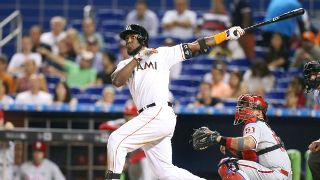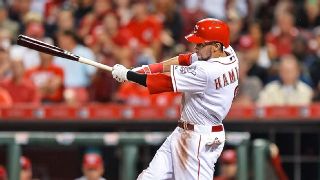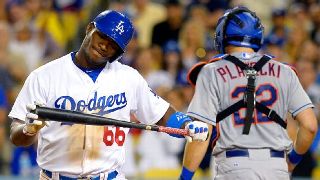|
We did make-or-break players to watch in the American League, so let's do the same for the National League. How can you predict how these guys will do? You can't. They're all lottery tickets, capable of excellent value or no value or somewhere in-between. They're the kind of players you need to hit on to win a fantasy league -- or the players who need to step up if their team is going to make the postseason. NL East Atlanta Braves -- Manny Banuelos, LHP Atlanta Braves -- Manny Banuelos, LHP
A lot of young players will get a shot with the Braves this year -- heck, Bud Norris is listed as the No. 2 starter on the team's website -- and Banuelos is still trying to recover the luster he once had as a prospect with the New York Yankees. I remember watching him in a spring training game a few years ago and his stuff was nasty. However, he had trouble throwing strikes and then he got injured. He's probably a reliever in the long run, but he has a chance to break camp in the rotation.   Miami Marlins -- Marcell Ozuna, OF Miami Marlins -- Marcell Ozuna, OF
He had a 4.5-WAR season in 2014 and then ended up back in the minors in 2015. The Marlins said it was because he was in a 1-for-36 slump. Agent Scott Boras said the Marlins were preventing Ozuna from being eligible for salary arbitration. Ozuna likened his time in Triple-A to "jail." Then he was mentioned in trade rumors all offseason. Oh boy.  New York Mets -- Addison Reed, RHP New York Mets -- Addison Reed, RHP
The Mets don't have an obvious "make or break" kind of player, so let's put Reed on the spot. Because the White Sox anointed him their closer when he was a rookie in 2012 and he has saved more than 100 games, he's making $5.3 million and there is the perception that he's a good reliever when ... well, he has a career 4.01 ERA. In the past four seasons, 73 pitchers have thrown at least 200 innings in relief and Reed ranks 68th in ERA. That doesn't mean he's bad -- the bad relievers don't stick around to throw 50-plus innings every season -- but he's going to be in a pressure role as a key setup guy for the Mets.  Philadelphia Phillies -- Jeremy Hellickson, RHP Philadelphia Phillies -- Jeremy Hellickson, RHP
The AL Rookie of the Year with Tampa Bay in 2011, Hellickson posted a 3.02 ERA through his first two seasons. Analysts said there was a lot of luck in his numbers -- BABIP, strand rate -- as he had a 4.52 FIP. Maybe the critics were right as he owns a 4.86 ERA over the past three seasons (he missed time in 2014 after elbow surgery). He moves on to his third team in three seasons ...  Washington Nationals -- Tanner Roark, RHP Washington Nationals -- Tanner Roark, RHP
Who is the real Tanner Roark? The one who posted a 2.85 ERA and 5.1 WAR in 2014 or the one who posted a 4.38 ERA and ended up in the bullpen in 2015? With the departures of Jordan Zimmermann and Doug Fister he's back in the rotation. Something weird to watch: His groundball rate was actually 7 percent higher in 2015 and yet his home run rate nearly doubled. In 2014, 6.8 percent of the fly balls he allowed went for home runs; in 2015, it jumped to 10.8 percent. The MLB average in 2015 was 11.4 percent, so Roark will need to find a way to get even more grounders given his low strikeout rate. NL Central Chicago Cubs -- Javier Baez, IF Chicago Cubs -- Javier Baez, IF
This one's a little unfair as Baez is unlikely to have a regular role unless somebody among the Cubs' regulars gets injured. You can even argue he should play every day in the minors, but the Cubs are trying to win and he's their best backup option in the infield. Manager Joe Maddon loves him; it's just an issue of finding him enough playing time so he doesn't get rusty and strike out twice a game when he does start.   Cincinnati Reds -- Billy Hamilton, CF Cincinnati Reds -- Billy Hamilton, CF
A classic make-or-break season: A young player who was good enough as a rookie in 2014 (especially when factoring in speed and defense), but hit just .226/.274/.289 in 2015. That's not good enough to remain a starter.  Milwaukee Brewers -- Wily Peralta, RHP Milwaukee Brewers -- Wily Peralta, RHP
He missed time with an oblique strain in 2015, but that doesn't explain away his 4.72 ERA in 20 starts with poor peripherals across the board. He relies on a power sinker, but it wasn't sinking much in 2015 and batters hit his fastball (four-seamer plus sinker) for a .340/.396/.525 line and his overall strikeout rate plummeted from 18.4 percent to 12.6 percent. I was skeptical that his 17-win season in 2014 was a true breakout and now he has to show the Brewers he's a guy they can build a rotation around.  Pittsburgh Pirates -- Jeff Locke, LHP Pittsburgh Pirates -- Jeff Locke, LHP
An All-Star in 2013 after he had a big first half, Locke has seen his ERA rise from 3.52 to 3.91 to 4.49. An already thin rotation is depending on Locke to have a bounce-back season. If not, rookies Tyler Glasnow and Jameson Taillon are waiting in the wings. Locke's strikeout and groundball rates have actually remained consistent and he's cut down on his walk rate, so his year-to-year fluctuation has mostly been about stranding runners: He was good (or lucky) in 2013 and poor (or unlucky) in 2015.  St. Louis Cardinals -- Matt Adams, 1B St. Louis Cardinals -- Matt Adams, 1B
Coming off a big postseason in 2014 when he hit three home runs -- including the game-winning blast off Clayton Kershaw in Game 4 of the Division Series -- the Cardinals expected Adams to be a primary power source for 2015. Instead, he tore a quad muscle and missed four months. The home run against Kershaw notwithstanding, Adams is a career .197 hitter against lefties so he needs a platoon partner anyway. Plus he's now battling Brandon Moss (another lefty hitter) for playing time. NL West Arizona Diamondbacks -- Jean Segura, SS/2B Arizona Diamondbacks -- Jean Segura, SS/2B
He made the NL All-Star team with the Brewers in 2013 after having a monster first half, but he hasn't hit since. He's gone from 42 extra-base hits in 2013 to just 27 last season as he's become an extreme groundball hitter. It doesn't help that he swings at everything (he had the worst walk rate of any regular in 2015) and his defense isn't so good to carry his bat. The Diamondbacks will try him at second base along with shortstop, but his future appears to be as a utility player.  Colorado Rockies -- Jordan Lyles, RHP Colorado Rockies -- Jordan Lyles, RHP
I feel guilty criticizing any Rockies pitcher, but Lyles now owns a career 5.14 ERA in 97 major league starts and he missed the final four months of last season after having toe surgery. Given the Rockies' new emphasis on fastball velocity and Lyles' average-ish 92.0 mph heater, his spot in the rotation is tenuous.   Los Angeles Dodgers -- Yasiel Puig, RF Los Angeles Dodgers -- Yasiel Puig, RF
This one isn't quite like the others, but Puig certainly has a lot at stake in 2016. The Dodgers will put up with his antics if he produces like he did in 2013 and 2014, but not if he hits .255/.322/.436 again and spends half of the season on the disabled list. New Dodgers manager Dave Roberts could be a huge help, and I'm predicting Puig bounces back with an All-Star season.  San Diego Padres -- Wil Myers, 1B San Diego Padres -- Wil Myers, 1B
Myers has played just 147 games over the past two seasons -- he had injuries to both wrists -- so his big thing is staying on the field in order to regain the batting stroke that won him AL rookie honors with the Rays in 2013. Was he overhyped as a prospect? Maybe a bit, but at various times he's hit for power, shown some patience at the plate and he did hit .293 as a rookie. He's also moving to first base on a regular basis after starting 19 games there in 2015, so there's even more pressure for him to produce offensively.  San Francisco Giants -- Hunter Strickland, RHP San Francisco Giants -- Hunter Strickland, RHP
The Giants are mostly a team of veterans or young veterans who have already proven themselves. The bullpen that has been around forever is finally starting to show some age -- Jeremy Affeldt retired, Santiago Casilla is 35, Sergio Romo is 33 -- so Strickland has a chance to become a primary setup guy after he had a pretty good rookie season in 2015. Those home runs he allowed in the 2014 postseason will linger in the minds of Giants fans, but Strickland could be a future closer if Casilla or Romo falter.
|
